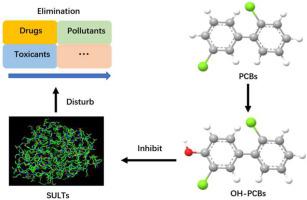Environmental Pollution ( IF 8.9 ) Pub Date : 2021-09-23 , DOI: 10.1016/j.envpol.2021.118214 Ruo-Yong Jia 1 , Zhi-Peng Zhang 2 , Guo-Qiang Qin 1 , Wei Zhang 1 , Kun Yang 1 , Yong-Zhe Liu 1 , Changtao Jiang 3 , Zhong-Ze Fang 4

|
Polychlorinated biphenyls (PCBs) have been demonstrated as a kind of the persistent organic pollutants (POPs) that could exert complicated influences towards metabolism in human bodies. Since hydroxylated polychlorinated biphenyls (OH-PCBs) are important metabolites of PCBs, our study focuses on investigating the potential inhibitory capability of OH-PCBs on four human sulfotransferase (SULT) isoforms. P-nitrophenol (PNP) was utilized as nonselective probe substrate for this study, and recombinant SULT isoforms were utilized as the enzyme resources. Ultra-performance liquid chromatography (UPLC)-UV detecting system was used to analyze PNP and its metabolite PNP-sulfate. As result, 100 μM of most tested OH-PCBs significantly inhibited the activity of four SULT isoforms. Concentration-dependent inhibition of OH-PCBs towards SULTs was found, and half inhibition concentration values (IC50) of some inhibition processes were determined. Inhibition kinetics (inhibition kinetic type and parameters) were determined using 4′–OH–PCB106 as the representative OH-PCB, SULT1B1 and SULT1E1 as representative SULT isoforms. The inhibition kinetic parameters (Ki) were 1.73 μM and 1.81 μM for the inhibition of 4′–OH–PCB106 towards SULT1B1 and SULT1E1, respectively. In silico docking simulation was utilized to analyze the inhibition capability of 2′–OH–PCB5, 4′–OH–PCB9, 2′–OH–PCB12 towards SULT1A3.All these results obtained in this study are helpful for further understanding the toxicity of PCBs.
中文翻译:

羟基化多氯联苯 (OH-PCB) 对磺基转移酶 (SULT) 的抑制
多氯联苯(PCBs)已被证明是一种对人体代谢产生复杂影响的持久性有机污染物(POPs)。由于羟基化多氯联苯 (OH-PCBs) 是 PCBs 的重要代谢物,我们的研究重点研究 OH-PCBs 对四种人类磺基转移酶 (SULT) 亚型的潜在抑制能力。本研究使用对硝基苯酚 (PNP) 作为非选择性探针底物,重组 SULT 异构体作为酶源。采用超高效液相色谱(UPLC)-UV检测系统分析PNP及其代谢物PNP-硫酸盐。结果,100 μM 的大多数测试的 OH-PCB 显着抑制了四种 SULT 同工型的活性。发现 OH-PCBs 对 SULTs 的浓度依赖性抑制,50 ) 的一些抑制过程被确定。抑制动力学(抑制动力学类型和参数)是使用 4'-OH-PCB106 作为代表性 OH-PCB,SULT1B1 和 SULT1E1 作为代表性 SULT 异构体来确定的。抑制4'-OH-PCB106 对 SULT1B1 和 SULT1E1的抑制动力学参数 (K i ) 分别为 1.73 μM 和 1.81 μM。计算机对接模拟用于分析 2'-OH-PCB5、4'-OH-PCB9、2'-OH-PCB12 对 SULT1A3 的抑制能力。印刷电路板。


























 京公网安备 11010802027423号
京公网安备 11010802027423号